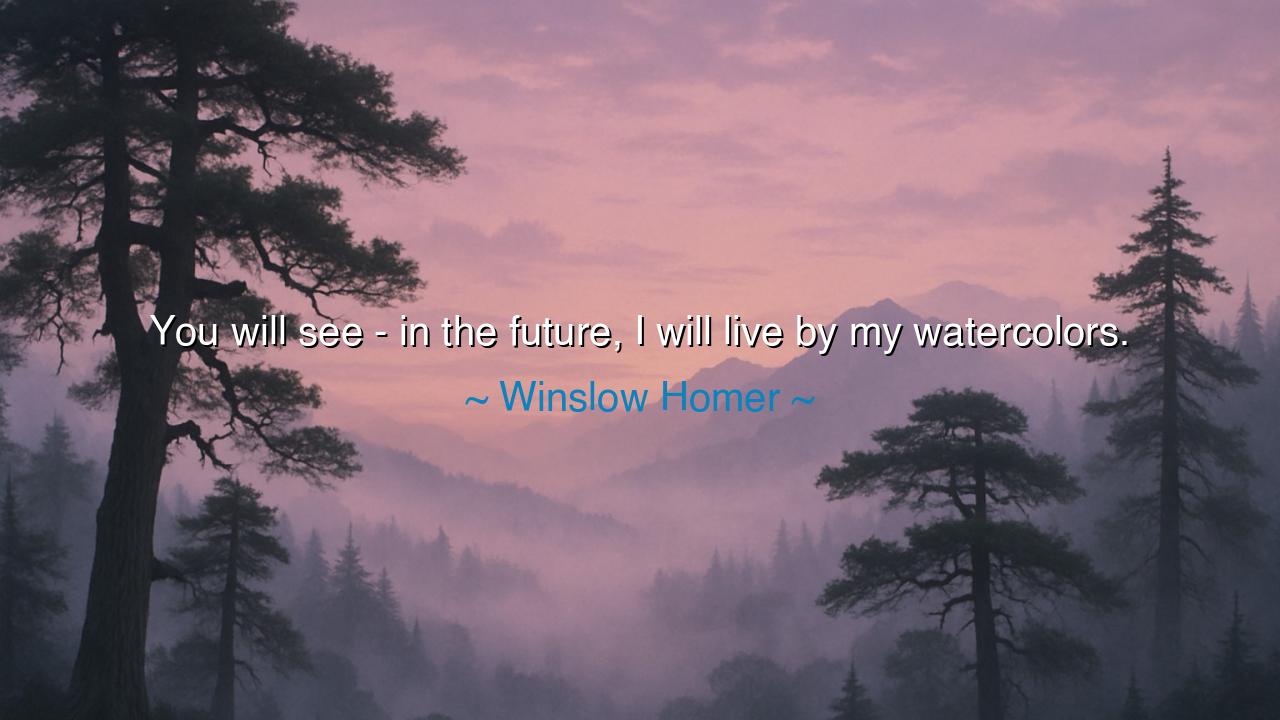
You will see - in the future, I will live by my watercolors.






"You will see - in the future, I will live by my watercolors." These words, spoken by Winslow Homer, express the quiet confidence and vision of an artist who believed deeply in the transformative power of his craft. Homer’s statement is not simply a declaration of his artistic intention; it is a profound understanding of how one’s passion, when nurtured and pursued with dedication, can become the foundation of a future—one that is both personally fulfilling and capable of sustaining the artist in the material world. The future, as Homer envisions it, will be defined by his art—a future in which he lives by and for his creativity, drawing sustenance not from conventional means, but from the raw power of his talent and vision.
In the ancient world, the artist was often seen as one who transcended the mundane concerns of survival to create something eternal and beautiful. The Greeks revered their sculptors and painters not only for their technical skills but for their ability to connect with the divine, to capture the essence of the human spirit in form and color. Plato, in his writings, understood that art was more than just a reflection of the world—it was a means by which individuals could connect to something greater, something transcendent. Homer’s watercolors would serve a similar purpose: through his art, he would carve out a space in the world for his soul to flourish, finding not only personal fulfillment but also an eternal legacy. Just as the great works of Phidias or Apelles shaped the cultural memory of ancient Greece, so too would Homer’s paintings and watercolors become his own contribution to the everlasting conversation between the artist and the world.
The idea of living by one’s art is not just about sustaining oneself financially; it is about creating a life that is authentic and true to one’s deepest passions. In this way, Homer’s statement speaks to the heart of what it means to truly live one’s purpose. Michelangelo, a towering figure of the Renaissance, similarly believed that his art was not merely a craft but a calling. He spent his life creating masterpieces, from the Sistine Chapel to the statue of David, not because he sought wealth or fame, but because he was driven by an inner necessity to express the divine beauty he saw in the world. Michelangelo’s dedication to his craft allowed him to live by his art, not just for the accolades it brought him, but because his art was the very purpose of his existence. Similarly, Homer understood that the work he poured into his watercolors was the vehicle through which he would both live and leave his mark on the world.
Homer’s confidence in his ability to live by his watercolors serves as a reminder that the pursuit of art is not a whimsical fantasy, but a profound and powerful act of self-determination. In the modern age, many creative individuals still follow this path. Take, for example, Frida Kahlo, whose iconic paintings were not just a reflection of her emotional and physical suffering, but a means by which she crafted a legacy. Kahlo lived not by conventional means, but by the power of her paintings and her vision of herself as an artist. Kahlo's commitment to her art, despite the physical and social obstacles she faced, made her one of the most influential figures of the 20th century. Like Homer, she understood that art could be both a means of personal expression and a source of sustenance, both spiritual and material.
The lesson from Homer’s declaration is that passion and purpose can create a future that is not dependent on societal norms or external validation. When we fully embrace our artistic selves, whether that be through visual arts, music, writing, or any other form of creative expression, we create a space where fulfillment and sustainability are not mutually exclusive. Homer’s life, like that of many great artists, serves as a reminder that true success is not found in wealth or fame, but in living fully in alignment with one’s passion. The future becomes not a set of external circumstances, but a canvas upon which we can paint our most authentic life.
In practical terms, this means that we should all look to our passions—whether they are in art, music, science, or any other field—and commit ourselves to them with dedication and focus. As Homer lived by his watercolors, we too must find the courage to live by what we love. The world will not always make room for our artistic pursuits, but if we remain true to our calling, we can carve out a space where our passions provide sustenance for both our souls and our livelihoods. The future we desire can be shaped by our own hands, and it is through our commitment to our craft that we can achieve a life of meaning and purpose.
Finally, let us remember that art is not confined to the world of painting or sculpture. It can be found in the way we live, the work we do, and the relationships we nurture. Just as Homer poured his soul into his watercolors, so too can we pour our energy into the things that bring us the deepest joy and meaning. The future we build is not one of mere survival, but one of living fully, deeply, and authentically through our passions. Let us look to the example of Homer and others who have dedicated their lives to their art and take inspiration from them as we pursue our own unique paths.






AAdministratorAdministrator
Welcome, honored guests. Please leave a comment, we will respond soon